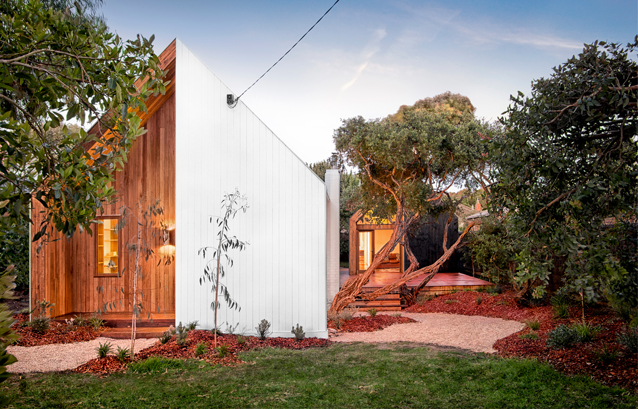It is rare to find a more quintessentially Australian setting than the subject of this project: a dilapidated weatherboard structure, nestled in a coastal context at Barwon Heads on the Bellarine Peninsula, that had originally been a worker’s cottage from the Snowy River Scheme and was transported to the site as cheap, ready-made accommodation. So it is unsurprising that the architects, presented with a brief to expand and renovate the home, were keen to preserve the personality of the dwelling as much as possible.

Thus as Kate Fitzpatrick, Principal at Auhaus Architecture states, “Our renovation is a simple yet lyrical design solution that retains the essence of the original house and evokes memories of our own childhood beach holidays. The design exaggerates the gabled form of the original front facade, opening up the interior with soaring cathedral ceilings to 5.8m high.”

The intervention consists of stretching the footprint of the existing structure a small amount to allow for a new living zone, while a new, separate guest pavilion essentially doubles the floor space, housing two extra bedrooms, a bathroom and living room, and linking to the main house via a timber deck.

The materiality of the project is particularly revealing, as economical, utilitarian materials such as lightweight timber framing, plywood sheet cladding and colorbond eschew any possible pretence. Complementing these, recycled, feature-grade Blackbutt flooring was chosen to emphasize the natural character and movement of the timber grain, and the kitchen island bench, made from solid Stringybark planks, sits as a central feature in the open plan living and kitchen space. Pressed metal walls and the hound’s-tooth tile kitchen splash back punctuate the timbers, adding layers of texture to the living zone without dominating the space.

The material palette maintains its resonance in the external context of the home, echoing the mature trees that seem to grow from the foundations themselves. In particular the twisted Ti trees provide a distinct aesthetic flavour, creating a pleasing contrast with the clean lines of the built areas. Highlights of copper, burnt orange and olive further connect the house to its surroundings, reflecting the rich colours in the surrounding native landscape.

The project, a case study in the Make It Wood campaign on account of its parsimony and responsible use of timbers, is all the more laudable for its low price tag. At $270,000, and the first project from the young architecture firm, it is a welcome reminder that good design is not the sole preserve of the already established or fabulously wealthy.
Auhaus Architecture
auhaus-arch.com.au
Make It Wood
makeitwood.org
Photography: Lance Van Maanen
lancevanmaanen.com

